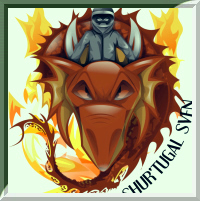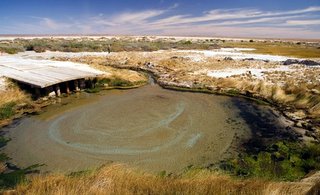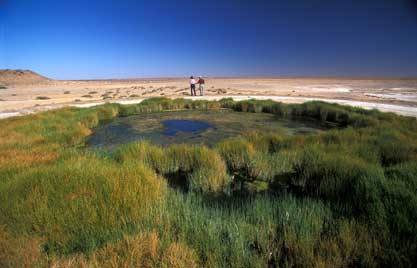
 |
|
Stories Told by Reg Dodd
Introduction: Reg Dodd I Reg told these stories to Pru Coulls who, with her partner, Greg Emmett, owns and runs the campground and surrounds at the Coward Springs siding. Prue kindly supplied me with transcripts, which I have edited slightly in places for presentation here. The stories are published here with Reg’s permission. There is a map at the bottom of the page indicating the location of places mentioned in Reg's stories.
The Stories – as told by him Stories of the Beginning – the Dreamtime (These are Reg's words) Around Coward Springs North of Coward Springs, the road passes between two hills. One is a brown hill – that’s on the south-western side of it; and, on the north-eastern side of it, is a white hill. Now, the story, our story, that relates to the creation of the hills and that, this is where the seven sisters used to come down through the night to dig up yulka – we call yulka – I think the Europeans identify it as a bush onion. They would dig it all up – and you see all the break-away areas where they used to dig up the area creating some of them springs and that. And they would peel the yulkas and they would put the skins of the yulka on the south-western side of the road all over the brown hill; and, on the north-eastern side, they would stack all the fruits of the bush onion, the yulka. When you peel the yulka, you see white bulb. We call that yulka nuri. The brown skin we call yulka burroo. So that’s the creation of that hill there. Now, these stories are told to us so that we can identify with the land feature. Whereas, I mean nearly every Aboriginal group in Australia has a story that identifies or links with the seven sisters, but the differences are that the stories links to different land features. Now I couldn’t go into another area and say, “well, I’ve got seven sisters dreaming too.” Well, I do, but it doesn’t apply to their land. It’s really to link you to that land, and that story gives you, like, a title of deed to that land, because you can identify with that land through that story. You’re linked through that story to that land. The Original Coward Springs
The Creation of the Bubbler
But the moral behind that story is, young fella, is you got lolly there or something, or something good, you gotta share, you gotta share, otherwise your manadi bust.
Stories about the Railway and Coward Springs Coward Springs as a Railhead
You might think that they would unload stock further south, but they couldn’t unload stock in Marree because they had to get them over the ranges to stations such as Mulgaria and Witchelina. They had to unload them here. “It was very important, here in Coward Springs.” For the railway, this place was a water hole. It used to be the place where all the train crew used to quench their thirst. But it was not only important for all that stuff. The old guy who owned the pub used to be a saddler. He was the best saddler in the country. They used to send down saddles from the Territory and from up in Queensland for him to put the [unclear] on the saddles; and he used to make the best saddles and bridles in the country. The next station master’s residence after Coward Springs was Oodnadatta. After Oodnadatta, the next one was Finke. Reg and the Railway I worked on the railway for 26 years … I finished in ’86. I started…in ‘66 as a train examiner. Before that, I worked on the railway contract. What would happen is you would always crib a couple of minutes here and a couple of minutes there. By the time we left Marree, you would book yourself out of Marree – what time it was – and then you’d have to book in again, say, at Alberrie Creek. So you’d book in a bit late and then you would say to the driver “I’m going to leave at 3.15,” but actually you’d probably leave at 3.00, as you’d know where the trains were. So you’d have quarter of an hour. And the same would happen here. And so, by the time you got here, you would have that much time up your sleeve, see,… so the moment you arrive at a siding, I think you’d have to book in straight away. They’d wait for about 10 minutes or quarter of an hour and then they would book in. “Oh, just got in” – and they’d been sitting in there a quarter of an hour. The Railway and Aboriginal Employment The railways were responsible for introducing the Aboriginal people into the paid work force. My old man, he got a job…I was about 10, I reckon, and we came up from Finniss Springs with a horse and cart - the old woman and the brothers, 4 brothers, dear little brothers. At Curdimurka, old Des Dunn, he was a senior road master, came up – and we was sitting under the tank and he saw the old man sitting there, never even saw him before. The old man, dark as your socks, he was. And old Des walked up and said to him, “Do you want a job, old fella?” and the old man said, ”Yeah”. He said, “Be down at Marree in a week’s time or whenever you get down and you can start.” So he got a job on the railways. Aboriginal people were working on the railways. Anyhow, that was Curdimurka, Wongianna and Alberrie Creek. So it gave the younger people some sort of incentive. Prior to that you were looking at how you could ride a horse or you wore a boxing glove or played the guitar or something like that. But then when the others came back with their pay envelope - they were actually getting paid for the jobs they were doing – and good money, and then your people said, “Well, I’m going to work on the railways too”. So a lot of the Finniss people got a job on the railway… Look at old Lennie there, he worked until he retired, he must have worked there 50 years. So then most of them were working on the railways; and from railways they were transferred to other government departments. Here is a map with the key places relevant to Reg’s stories. |
 This old hunter come round – they use to live there – big camp, used to be Gudnanamba. What’s now called Curdimurka. He come out one day to hunt and he come across this track, this strange snake track would come along. So he tracked him and the snake went into the hole, there off that Margaret Creek. So, he dug that hole out. He come to a dead end there, so he come out and then he dug that creek out and dug that hole out forming that creek that comes up to Margaret, twisting there, too far, “no, not in here.” He went back, back down by Horse Springs and started digging that little creek that runs into the Bubbler. Come out there, right up at the Bubbler, and he found the snake in the Bubbler, see, what you call the Bubbler. We call the Bubbler Kiltaga, that’s where he pulled that snake out. He pulled him out at the Bubbler and then he took him over to the Blanche Cup there, we call that Thirka. That’s where he cooked him – in the thirka. And he pulled him out and he broke him up, he chucked the head away forming that hill Wabma Kadarbu there, and he sat down, ’et that snake, and he caught a couple of little pigeons and a finch…(spoken in Arabunna language). And he took them back. When he got back to Gudnanamba, the old woman said “any… (spoken in Arabunna language)…he said “only…( spoken in
This old hunter come round – they use to live there – big camp, used to be Gudnanamba. What’s now called Curdimurka. He come out one day to hunt and he come across this track, this strange snake track would come along. So he tracked him and the snake went into the hole, there off that Margaret Creek. So, he dug that hole out. He come to a dead end there, so he come out and then he dug that creek out and dug that hole out forming that creek that comes up to Margaret, twisting there, too far, “no, not in here.” He went back, back down by Horse Springs and started digging that little creek that runs into the Bubbler. Come out there, right up at the Bubbler, and he found the snake in the Bubbler, see, what you call the Bubbler. We call the Bubbler Kiltaga, that’s where he pulled that snake out. He pulled him out at the Bubbler and then he took him over to the Blanche Cup there, we call that Thirka. That’s where he cooked him – in the thirka. And he pulled him out and he broke him up, he chucked the head away forming that hill Wabma Kadarbu there, and he sat down, ’et that snake, and he caught a couple of little pigeons and a finch…(spoken in Arabunna language). And he took them back. When he got back to Gudnanamba, the old woman said “any… (spoken in Arabunna language)…he said “only…( spoken in  Arabunna language)…only little sort of things.” And the old woman looked at him and said, “you must be telling lies” ‘cos all his whiskers shiny and all that see, all fat and that on it. So the old woman said “I fix him up.” So the old woman went down the creek there, started singing then and put a spell on him - singin’, singin’ there - next minute the old fella started to get pains and, then he went down the creek he was laying down rollin’ around in the creek – “manadi…(spoken in Arabunna language)…” swelled up then, his testicles, swelled up. And they sing out then to all the people, “Come and have a look, this old…(spoken in Arabunna language)…” and he was still rolling around and all the people were standing around looking at him. All bar one old woman who was blind and the girl who was leading that blind old woman. They was up on top of the sand hills at Gudnanamba. The two little tea-trees there now – that’s the old woman and the girl. And all the old people come there looking at the old fella. Next minute, his manadi just exploded, busted. All the lava and that turned into little round rocks you got in there now in the creek, Gudnanamba, you find all these rocks there, well that’s that old fella’s manadi.
Arabunna language)…only little sort of things.” And the old woman looked at him and said, “you must be telling lies” ‘cos all his whiskers shiny and all that see, all fat and that on it. So the old woman said “I fix him up.” So the old woman went down the creek there, started singing then and put a spell on him - singin’, singin’ there - next minute the old fella started to get pains and, then he went down the creek he was laying down rollin’ around in the creek – “manadi…(spoken in Arabunna language)…” swelled up then, his testicles, swelled up. And they sing out then to all the people, “Come and have a look, this old…(spoken in Arabunna language)…” and he was still rolling around and all the people were standing around looking at him. All bar one old woman who was blind and the girl who was leading that blind old woman. They was up on top of the sand hills at Gudnanamba. The two little tea-trees there now – that’s the old woman and the girl. And all the old people come there looking at the old fella. Next minute, his manadi just exploded, busted. All the lava and that turned into little round rocks you got in there now in the creek, Gudnanamba, you find all these rocks there, well that’s that old fella’s manadi.